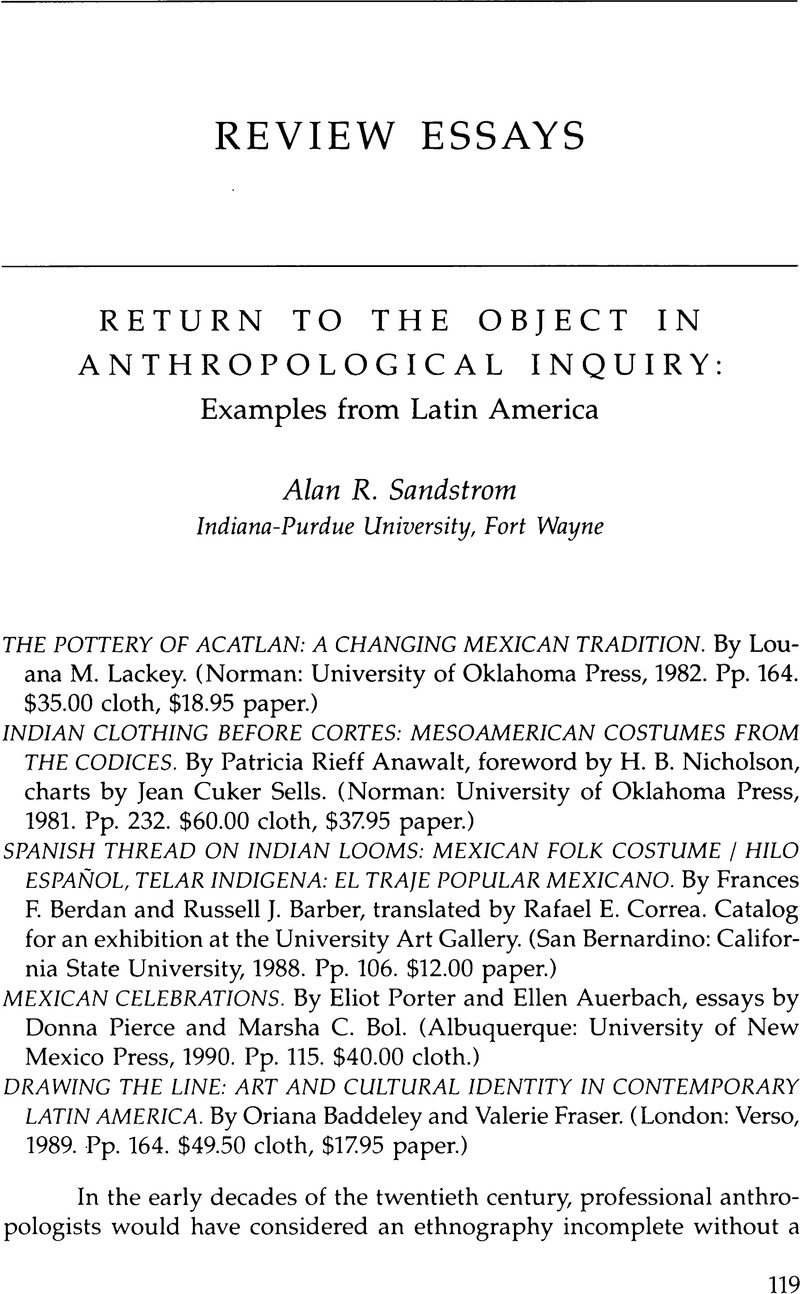No CrossRef data available.
Article contents
Return to the Object in Anthropological Inquiry: Examples from Latin America
Review products
Published online by Cambridge University Press: 05 October 2022
Abstract

- Type
- Review Essays
- Information
- Copyright
- Copyright 1994 by the University of Texas Press
References
1. Harry R. Silver, Ethnoart, Annual Review of Anthropology 8 (1979):267-307, see 26972.
2. A number of scholars have noted this trend, including Brian Durrans, Behind the Scenes: Museums and Selective Criticism, Anthropology Today 8 (1992):11-15, see 11; Stanley A. Freed, Everyone Is Breathing on Our Vitrines: Problems and Prospects of Museum Anthropology, Curator 34, no. 1 (1991):58-79, see 7475; Remo Guidieri and Francesco Pellizzi, Editorial, Res, no. 1 (1981):36 (published in Cambridge, Mass.); Francesco Pellizzi, Editorial, Res, nos. 1920 (1990-91):57; Material Anthropology: Contemporary Approaches to Material Culture, edited by Barrie Reynolds and Margaret A. Stott (Lanham, Md.: University Press of America, 1987), 2; and Nancy McDowell, Special Meeting in a Special Place: Arts and Goods in Santa Fe! Anthropology Newsletter 33, no. 6, (1992):6. See also Objects and Others: Essays on Museums and Material Culture, edited by George W. Stocking, Jr., (Madison: University of Wisconsin Press, 1985).
3. Recent criticisms of the display of material culture in museums include James Clifford, The Predicament of Culture: Twentieth-Century Ethnography, Literature, and Art (Cambridge, Mass.: Harvard University Press, 1988), especially chaps. 910; and Exhibiting Cultures: The Poetics and Politics of Museum Display, edited by Ivan Karp and Steven D. Lavine (Washington, D.C.: Smithsonian Institution Press, 1991).
4. See Eva Hunt, The Transformation of the Hummingbird: Cultural Roots of a Zinacantecan Mythical Poem (Ithaca, N.Y.: Cornell University Press, 1976); and Alfredo Lpez Austin, The Human Body and Ideology: Concepts of the Ancient Nahuas, translated by Thelma Ortiz de Montellano and Bernard Ortiz de Montellano (Salt Lake City: University of Utah Press, 1988), 22.
5. Sheldon Annis, God and Production in a Guatemalan Town (Austin: University of Texas Press, 1987). See also Martin Prechtel and Robert S. Carlsen, Weaving and Cosmos amongst the Tzutujil Maya of Guatemala, Res no. 15 (1988):12232. In this article, Prechtel and Carlsen show how weaving and the headcloth are symbolically linked to birth and world renewal among the modern Maya.
6. Silver, Ethnoart, 269.
7. See Edward Ranney, Recent Latin American Photography Books, LARR 26, no. 3 (1991):23546.
8. Karp and Lavine, Exhibiting Cultures, 4.
9. See similar treatments appearing in Ethnic and Tourist Arts: Cultural Expressions from the Fourth World, edited by Nelson H. H. Graburn (Berkeley and Los Angeles: University of California Press, 1976).
10. Brvan Pfaffenberger, Social Anthropology of Technology, Annual Review of Anthropology 21 (1992):491516.
11. George Basalla, The Evolution of Technology (Cambridge: Cambridge University Press, 1988), 711; see also Colin Renfrew, Varna and the Emergence of Wealth in Prehistoric Europe, in The Social Life of Things: Commodities in Cultural Perspective, edited by Arjun Appadurai, 14168 (Cambridge: Cambridge University Press, 1986).
12. Basalla, The Evolution of Technology, 7.
13. For a recent review of the topic, see Michelle Hegmon, Archaeological Research on Style, Annual Review of Anthropology 21 (1992):51736.
14. Pfaffenberger, Social Anthropology of Technology, 504.
15. For example, see Appadurai, The Social Life of Things; Catharine Good Eshelman, Haciendo la lucha: arte y comercio nahuas de Guerrero (Mexico City: Fondo de Cultura Econmica, 1988); Nancy D. Munn, Walbiri Iconography: Graphic Representation and Cultural Symbolism in a Central Australian Society (Ithaca, N.Y.: Cornell University Press, 1973); Alan R. Sandstrom and Pamela Effrein Sandstrom, Traditional Papermaking and Paper Cult Figures of Mexico (Norman: University of Oklahoma Press, 1986); Margot Blum Schevill, Costume as Communication (Bristol, R.I.: Haffenreffer Museum of Anthropology, Brown University, 1986); Textile Traditions of Mesoamerica and the Andes: An Anthology, edited by Margot Blum Schevill, Janet Catherine Berlo, and Edward B. Dwyer (New York: Garland, 1991); and Jane Schneider, The Anthropology of Cloth, Annual Review of Anthropology 16 (1987):40948.
16. One example of this renewed interest is the decision of the American Ethnological Society to designate material culture as the theme for its 1993 annual meeting, Arts and Goods: Possession, Commoditization, Representation.


